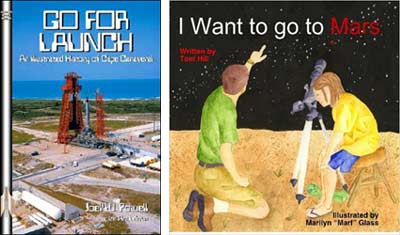Reviews: picture books for young and oldby Jeff Foust
|
| Joel Powell and Art LeBrun have dug through decades of photos of Cape Canaveral, providing images of virtually every launch vehicle and missile that used the Cape dating back to the site’s origins as a missile testing range over a half-century ago. |
That oversight, though, can be neglected given the wealth of images from the Cape included in the book. While there are a number of well-known images included in the book, the bulk of the book features many more less-famous images of various rocket programs, many of which had long faded into obscurity. There are also a lot of photos of the facilities at the Cape, showing the evolution of the site over nearly six decades. While many of the photos are in black and white, the book shifts to glossy paper for about 60 pages near the end to print color photos, mostly of more contemporary launch vehicles (from the 1980s through the present day), although some older color photos are included. All the photos have detailed captions accompanying them, and there is a brief historical essay about the Cape at the beginning of the book. Although there are a few errors in the captions (one refers to the Cape being on the west coast of Florida), the result is still a fascinating book of images that captures the evolution of America’s principal spaceport.
I Want to Go to Mars is a very different book, one intended for children. The book tells the tale of a young girl who, as the title suggests, wants to travel to Mars. In simple text, with full-page color illustrations, the book describes what it would be like to travel to and live on the Red Planet. The book is primarily intended for children from between pre-kindergarten through second grade, Tom Hill and Marilyn Glass (the writer and illustrator, respectively) explained at the Mars Society conference in Washington last weekend. However, the last two pages feature a “Mars Data File” for older audiences to provide more details about the subjects mentioned in the book itself, such as why the girl’s hair turns blonde once on Mars (not a continuity error, as one might first suspect: it’s the effect of the peroxides in the Martian soil.)
Hill (author of another space book, Space: What Now?, previously reviewed here) and Glass explained at the conference that they’re trying to get the book accepted by a mainstream children’s book publisher, but without success so far. That’s why, for now, the book is available at the print-on-demand publisher Lulu, albeit at a higher price than what a traditional publisher might charge. Although the authors are still looking for a publisher to pick up the book, if you have or know children of the right age with an interest in space, there’s little reason to wait until then to get a copy.
